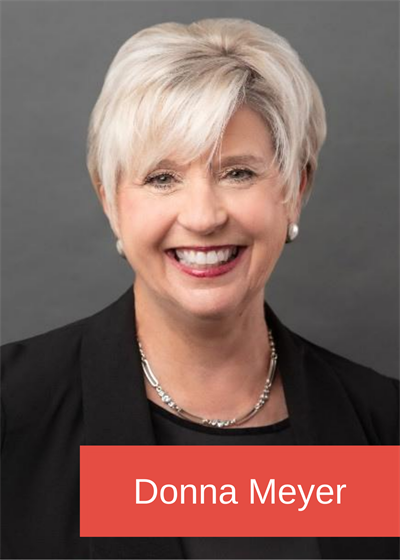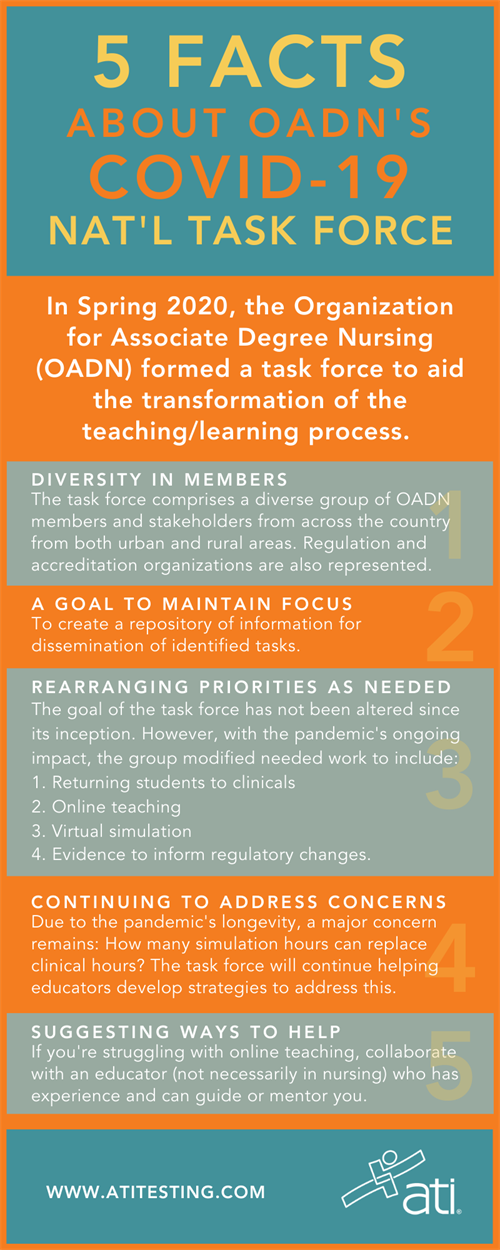OADN'S SMART STEPS PROVIDE SUPPORT FOR NURSE EDUCATORS
OADN'S BEST-EXPERT TASK FORCE HELPS FACULTY FACE THE ULTIMATE CHALLENGE: COVID
 As Chief Executive Officer of the Organization for Associate Degree Nursing (OADN), Donna Meyer, MSN, RN, ANEF, FAADN, FAAN, is always focused on the group’s vision: To expand networks that promote leadership, collaboration, and advocacy to further enrich nursing education and the communities we serve.
As Chief Executive Officer of the Organization for Associate Degree Nursing (OADN), Donna Meyer, MSN, RN, ANEF, FAADN, FAAN, is always focused on the group’s vision: To expand networks that promote leadership, collaboration, and advocacy to further enrich nursing education and the communities we serve.The need for those networks was never more profound than when the COVID-19 pandemic tidal-waved over the world in Spring 2020. To help educators as they continue to cope with the pandemic’s impact on teaching, ATI asked Meyer to provide some insight into her organization’s efforts to help. Specifically, Meyer discussed the creation of the OADN COVID-19 National Task Force — and what’s been happening in the months since.
Q: When the task force was first formed, what was its most immediate goal?
Meyer: The unprecedented COVID-19 pandemic impacted nursing education programs across the country and provided many challenges. The pandemic required a transformation in the teaching/learning process. OADN always strives to support nursing education programs and, as a result, formed the OADN COVID-19 National Task Force.
The task force met in early June and comprised a diverse group of OADN members and stakeholders from across the country from both urban and rural areas. Regulation and accreditation organizations are also represented on the task force. The purpose was to provide a national perspective and guided consideration and to generate ideas to address future teaching/learning structures and opportunities in nursing education.
The goal of the task force: To create a repository of information for dissemination of the identified tasks.
At the initial meeting, the task force chose to identify workgroups to complete the initiative as quickly as possible. The workgroups formed were:
- Collaboration with industry partners
- Online education
- Simulation/virtual simulation
- Regulation/accreditation.
Each work group:
- Identified innovative methods of restructuring the teaching/learning process
- Recognized the need for modifications based on the pandemic
- Developed strategies for providing meaningful clinical learning opportunities
- Discussed academic/practice partnership considerations
- Created a plan for collaborating with industry partners for high quality and safe return of students to clinicals.
Q: How has the goal changed as the pandemic continues?
 Meyer: The goal of the task force has not been altered since the task force’s inception. However, the categories of the needed work were modified to include the following areas:
Meyer: The goal of the task force has not been altered since the task force’s inception. However, the categories of the needed work were modified to include the following areas:
- Conducting safe clinicals and labs during COVID-19
- Online teaching
- Virtual simulation
- Evidence to inform regulatory changes.
Q: What questions are task force members currently trying to answer for educators right now?
Meyer: I think one of the fundamental issues on which task force members are still focused is clinical education. Many programs continue to have challenges for clinical placements. This varies across the country from region to region. Additionally, as the COVID situation can change quickly, nursing administrators and educators must be able to pivot quickly. Thus, the task force has provided resources on virtual simulation for clinical replacement, for example.
OADN was part of the nation’s nursing leadership that was involved in developing the policy brief, “U.S. nursing leadership supports practice/academic partnerships to assist the nursing workforce during the COVID-19 crisis.” The brief issued recommendations for academic-practice partnerships between healthcare facilities and prelicensure nursing education programs. This is an innovative strategy to assist students to complete necessary clinical hours.
DOWNLOAD THE INFOGRAPHIC AT RIGHT AS A HANDY REFERENCE
Q: What new issues has the task force seen surface since it was formed?
Meyer: The longevity of the pandemic and the ever-changing landscape has caused new issues to arise on a continual basis. Some of the major concerns are still related to the number of clinical hours that can be replaced with simulation and virtual simulation. Some of the waivers have expired in states, and that situation is causing some concern. Additionally, limitations remain with some Boards of Nursing.
Continuing to develop creative strategies for clinical education remains a high priority.
Q: What direction or advice can you provide to educators who continue to struggle with online teaching?
Meyer: Collaborate with another educator who has additional online teaching experience; that technique can be very beneficial. Keep in mind that the individual doesn’t have to be a nursing educator; he or she could be a faculty member from another discipline who simply has more online teaching experience. Online nursing education is new to our profession, but many disciplines have been providing online instruction for some time, so take advantage of their expertise.
Also check out the toolkit for online education that OADN created. It provides valuable resources.
Q: What positives do you see coming out of the sudden transition to online learning that will benefit nursing education?
Meyer: I think online teaching for didactic content may provide more flexibility for nursing education. Students often struggle with time management due to juggling family responsibilities, employment, and academic studies. Providing some online education may be a benefit for the learner.
I would like to add that we will conquer this pandemic, because nurses are resilient. We have encountered extraordinary times during these past months, and nurse educators have risen to the challenge and pivoted quickly to provide innovative solutions in nursing education.
On behalf of OADN, I applaud all nursing faculty for their continued dedication in educating the next generation of the nursing workforce.
